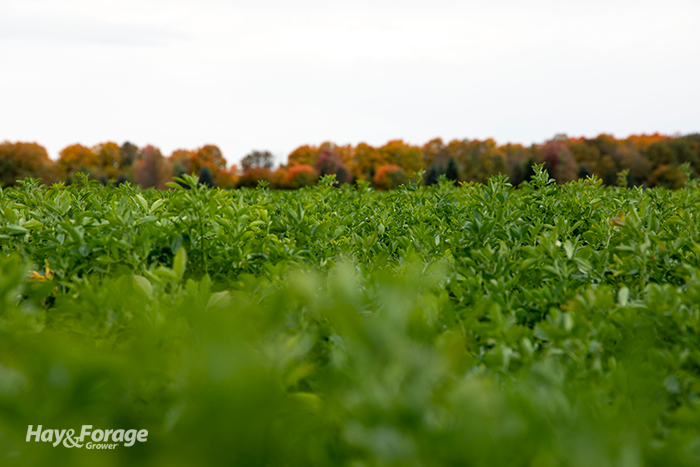
When you turn your smartphone on “do not disturb” mode, it quiets all activity, from texts to calls and other app notifications. It won’t ring, vibrate, or even light up the screen, which is useful when you’re headed into a meeting, going to bed, or just trying to limit your screen time. If alfalfa had a “do not disturb” mode that prohibited all activity in the field, now would be the time to turn it on.
The general rule of thumb is to cut alfalfa no less than five to six weeks before growth ceases in the fall. For many Northern states, this cutting date typically falls between early and mid-September, which is already in the rearview mirror. Now, we are approaching the critical fall period, also known as “the no-cut zone.”
This term was coined by Shelby Gruss in a recent article from Iowa State University Extension. The state forage specialist explains that the no-cut zone spans from about 900 to 360 alfalfa growing degree days (GDD) before the first killing frost, using a GDD lower base temperature of 41ºF. Cutting hay with more than 900 GDD on the horizon will ensure plants can replenish their root reserves before winter. On the other hand, if alfalfa is harvested with less than 360 GDD left in the growing season, plants aren’t likely to deplete their root reserves to fuel regrowth before colder weather sets in.
In both cases, the stand should be in good shape heading into winter. However, cutting hay during the no-cut zone risks that alfalfa will start to regrow but run out of time to photosynthesize and store sufficient carbohydrates. Gruss notes this process doesn’t start until plants are 6 to 8 inches tall.
Once the opportunity to cut hay before the 900-GDD mark passes, the trick is timing when the 360-GDD window will be. You can aim to cut hay roughly two weeks before the estimated first frost date in the region, but if warm weather persists, Gruss warns that the no-cut zone could get wider, and farmers could unintentionally fall into it. Of course, if the stand is going to be terminated, the threat of the no-cut zone ceases to exist.
Cutting hay after a killing frost is an option if farmers are in a pinch and need the extra forage, but it’s imperative to do so as soon as possible. Delaying harvest after a killing frost can lead to nutrient leaching and lower forage quality as plant tissues begin to break down. Moreover, weather conditions at this point in the season can be variable.
“Keep in mind that additional time may be needed to properly dry the alfalfa down with cooler temperatures and shorter days,” Gruss writes.
The state forage specialist adds that even though forage quality from fall alfalfa cuttings tends to be high, yields are often low. It’s also recommended to leave 4 to 5 inches of stubble height after a late fall harvest to protect the ground and insulate alfalfa crowns during the winter — but this will reduce yield even further.
“If you need high-quality hay, this might make the cutting worthwhile,” Gruss writes. Otherwise, it’s probably best to leave the forage in the field.
Leaving the forage is likely the best solution to ensure alfalfa has enough energy to get a head start on spring green up next year. More aboveground biomass can also catch snow and better insulate alfalfa crowns, protecting plants from frigid weather and cold winds. This ground cover also aids in preventing frost heaving when fluctuating temperatures cause soil to freeze and thaw.
How dry was it?
In addition to gauging growing degree days, assess this season’s moisture to decide if it’s practical to take a late fall cutting. Emma Matcham, Dave Barker, and Jason Hartschuh with Ohio State University Extension caution that summer drought conditions may make it harder for alfalfa to thrive through the winter, even if it’s harvested well ahead of the no-cut zone.
“Even though the taproot of alfalfa can continue growth during short-term dry weather, its growth is reduced by longer term drought conditions,” the extension specialists state. “This will reduce the recovery of growth of alfalfa going into the winter, increasing the risk that fall-cut alfalfa may not regrow sufficiently before a hard frost.”
If farmers need more forage, the specialists recommend waiting to cut hay until after the first hard frost, once plants have gone through winterization. “Winterization correlates to cutting after a killing freeze, after which the plant is dormant,” they state. “This is not as stressful to the plants as cutting during winterization and can be a viable option for those who need feed.”
Drought can hinder alfalfa persistence because of the way dry conditions affect potassium (K) uptake. The specialists explain that K is critical for cold tolerance and winter survival; however, even if soil tests show high levels of K, plant uptake may have been reduced in stands where moisture was limited this summer. “While low water availability impacts the uptake of all nutrients, K uptake is particularly sensitive to dry conditions due to interactions between K and clay particles,” they conclude.

